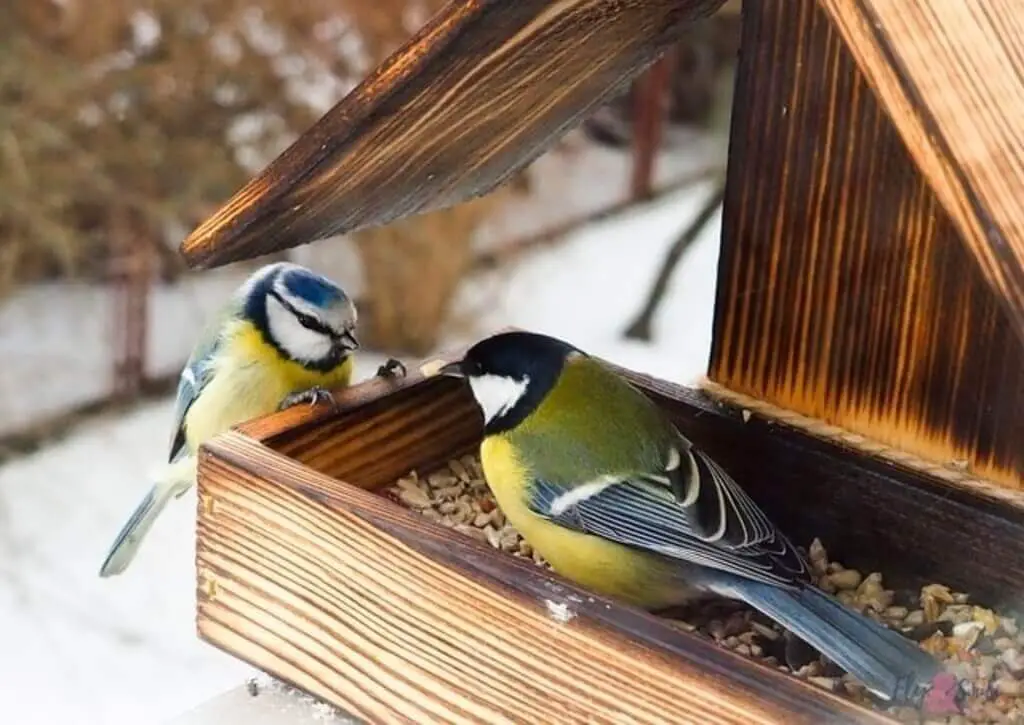As a birdwatcher with a passion for birds, I have always been intrigued by the behavior of birds at feeders. One common observation is the tendency of birds to throw seed out of feeders. But why do they do this?
In this article, we will explore the fascinating behavior of birds throwing seed out of feeders. We will delve into the reasons behind this behavior and provide insights into bird feeding habits.
Table of Contents
- 1 Key Takeaways
- 2 Why Do Birds Throw Seed Out Of Feeders?
- 3 Bird Behavior and Feeding Habits
- 4 Seed Wastage at Bird Feeders
- 5 Attracting Birds to Feeders
- 6 Understanding Bird Feeding Behavior
- 7 The Role of Beak Size and Shape
- 8 Seed Preferences and Selection
- 9 Environmental Factors and Feeder Placement
- 10 Managing Seed Spillage
- 11 Observing Birds and Adjusting Feeder Setup
- 12 Promoting Responsible Bird Feeding
- 13 Extra Tips
- 14 Conclusion
- 15 FAQs
- 15.1 How can I prevent seed spillage at bird feeders?
- 15.2 What are some bird feeding tips to attract birds to my feeders?
- 15.3 How does a bird’s beak size and shape influence seed spillage?
- 15.4 Do birds have preferences when selecting seeds?
- 15.5 How does the environment and feeder placement affect seed spillage?
- 15.6 What can I do to manage seed spillage at my feeders?
- 15.7 How can I observe birds and adjust my feeder setup?
- 15.8 How can I practice responsible bird feeding?
- 15.9 What causes birds to throw seeds out of feeder?
- 15.10 How can we stop birds from throwing seeds out of feeder?
- 15.11 How do I keep seeds from falling off my bird feeder?
- 15.12 How to stop bird seed from going everywhere?
- 15.13 How to stop bird seed from growing under feeder?
- 15.14 Do birds scatter seeds when feeding?
- 15.15 Will birds eat seed off the ground?
- 15.16 Do birds eat the whole seed when feeding?
- 16 Author
Key Takeaways
- Bird behavior and feeding habits impact their actions at bird feeders
- Inefficient seed wastage can be minimized through proper feeder placement and seed selection
- Observing bird behavior can help make adjustments to optimize their feeding habits
- Responsible bird feeding involves considering the impact on birds and the environment
- Understanding and managing seed wastage can create a more enjoyable and efficient feeding experience for both you and the birds
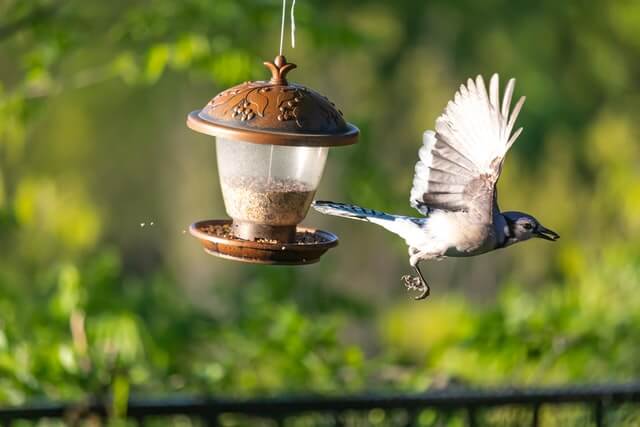
Why Do Birds Throw Seed Out Of Feeders?
Birds may throw seed out of feeders for several reasons. One common explanation is that they are searching for their preferred seeds and discarding the ones they don’t like. Additionally, some birds have feeding techniques that involve sorting through the seeds, resulting in occasional spillage. It’s also possible that the design of the feeder or the size and shape of the bird’s beak contribute to seed scatter.
Bird Behavior and Feeding Habits
In order to understand why birds throw seed out of feeders, it’s important to first examine their natural behavior and feeding habits. Birds have evolved over millions of years to survive in a variety of environments, and their feeding behavior reflects this adaptability.
One key factor to consider is the size and shape of a bird’s beak. Different bird species have evolved different beak shapes and sizes to best suit their specific feeding needs. Some birds have long, thin beaks that allow them to extract insects from tree bark, while others have shorter, stubbier beaks that are better suited for cracking open seeds.
Another important aspect of bird feeding behavior is their preference for certain types of food. While many birds will happily consume a wide variety of seeds, some may have specific preferences or aversions to certain types. For example, some birds may avoid seeds that are too large or difficult to crack open, while others may prefer smaller, softer seeds.
It’s also worth noting that birds have a natural instinct to search for food in a variety of locations. While feeders can certainly be a convenient source of sustenance, many birds will still continue to forage for food in their natural environment, even if they have access to a feeder.
Overall, understanding bird behavior and feeding habits can provide valuable insights into why they may be throwing seed out of feeders. By taking into account these natural tendencies, we can make adjustments to our feeder setup and feeding practices to better accommodate our feathered friends.
Seed Wastage at Bird Feeders
Seed wastage at bird feeders is a common issue that concerns many bird enthusiasts. There are various factors that contribute to seed spillage, including the type of feeder and the placement of the feeder. In addition, some bird species are known to be messy eaters, which can cause seed to scatter unnecessarily.
To prevent seed spillage, it’s crucial to choose the right type of feeder and appropriately place it. A platform feeder or a tray feeder can be an excellent option for birds that tend to scatter seed. These feeders have a flat surface that can catch any spilt seed, reducing wastage.
Another way to minimize seed wastage is to avoid overfilling the feeder. If there’s too much food in the feeder, birds may knock some of it out while attempting to reach for food. Instead, it’s better to refill the feeder regularly with smaller amounts of seed.
Additionally, investing in a feeder with a built-in seed catcher or tray can also help minimize seed wastage. The tray or catcher can help to catch any spilled seed and keep the feeding area clean.
Overall, preventing seed wastage is essential not only to reduce unnecessary costs but also for the health and safety of birds. By implementing these simple strategies, you can enjoy feeding birds while minimizing seed wastage and ensuring a more hygienic feeding area.
Attracting Birds to Feeders
Feeding birds is a delightful activity that provides many benefits to both you and the birds. Knowing how to attract birds to your feeders can enhance your bird feeding experience.
Here are some bird feeding tips to attract birds to your feeders:
- Place feeders in a visible location: Avoid placing feeders in low visibility areas or too close to bushes and shrubs. This can make it challenging for birds to locate their food, and they may not feel safe feeding in areas with limited visibility.
- Use a variety of feeders: Different species of birds have different feeding habits and preferences. Offering a variety of feeders can attract a diverse range of birds to your feeding area. Suet feeders, nectar feeders, and tube feeders are some popular choices among many bird enthusiasts.
- Provide fresh water: Water is essential for birds, and offering a fresh supply can attract them to your feeders. Consider placing a bird bath or shallow basin near your feeding area.
- Use high-quality food: Providing high-quality seeds and food can attract a variety of birds and ensure they are receiving adequate nutrition.
- Keep feeders clean: Regularly cleaning your feeders can help prevent the spread of disease and keep your feeding area tidy and inviting for birds.
By implementing these bird feeding tips, you can attract a variety of birds to your feeders and enjoy watching them feed and interact in their natural habitat.

Understanding Bird Feeding Behavior
Bird feeding behavior is a complex and fascinating subject that can shed light on why birds throw seed out of feeders. By understanding how birds consume seeds, we can better comprehend their actions.
It’s essential to note that different bird species have different feeding habits. Some birds will consume all the seeds they can find, while others are more selective. This behavior could be influenced by factors such as the bird’s size, diet, and natural habitat.
Birds typically consume seeds by holding them in their beaks and cracking them open with their bills. However, some birds may remove the seed husks before consuming the seed, leading to wastage.
To prevent seed wastage, it’s essential to provide the right type of seeds that the birds prefer. Observing the birds and adjusting the feeder set up based on their behavior can help reduce seed spillage. Additionally, placement of the feeder in areas free of predators can help birds feel more at ease while consuming the seed.
In summary, understanding bird feeding behavior is crucial to preventing seed wastage and promoting efficient bird feeding.
The Role of Beak Size and Shape
Bird beak size and shape play a crucial role in their feeding behavior. A bird’s beak is uniquely adapted to its environment and food sources, and each species has a distinct shape and size.
The structure of a bird’s beak can determine how it handles and consumes seeds, which can impact the amount of seed spilled from a feeder. For example, birds with thin, pointed beaks may have a harder time grasping larger seeds and more likely to drop them. On the other hand, birds with thicker, stronger beaks may have an easier time cracking open larger seeds, but may have difficulty handling smaller ones.
It’s worth noting that not all birds have the same beak type within their species. Beak size and shape can vary depending on sex, age, and location. Therefore, it’s important to consider the unique feeding behavior of the birds frequenting your feeders when examining why seed spillage may occur.
By observing the beak characteristics of bird species visiting your feeders, you can better understand their feeding habits and how to optimize seed consumption. Providing a variety of seed types and sizes can also cater to the beak size and shape of different bird species, reducing seed wastage.
Seed Preferences and Selection
When selecting the type of seed to provide in your bird feeder, it’s essential to consider the seed preferences of the birds you are trying to attract. Different bird species have varying preferences for seed type, size, and texture. Providing seeds that birds don’t like may result in more seed wastage.
Black oil sunflower seeds are the most popular seed for bird feeders. They are high in fat and protein, making them an excellent source of energy for birds. Other common bird seed types include millet, safflower, nyjer, and cracked corn.
Observing the birds that visit your feeder can give you insight into their preferred seed types. You may notice that some birds prefer to eat certain seeds, while others ignore them. By adjusting the type of seed provided, you can attract more birds and reduce seed wastage.
It’s also important to consider the size of the seed you are providing. Birds with larger beaks, such as cardinals, can handle larger seeds like sunflower seeds. Smaller birds, such as finches, prefer smaller seeds like nyjer. Providing a mix of seed types and sizes can attract a wider variety of birds and reduce the likelihood of seed wastage.
Seed Consumption
Understanding how birds consume seeds can also help reduce seed wastage. As birds pick at seeds, they may knock them out of the feeder, causing them to scatter on the ground. This is where selecting the appropriate feeder design can make a significant impact.
Tube feeders are designed to dispense seed slowly, reducing the amount of seed that falls to the ground. Additionally, tray feeders can catch any seed that falls out of the feeder, making it available for birds to eat.
By selecting the appropriate seed type and providing it in the correct feeder design, you can reduce seed wastage and attract a wider variety of birds to your feeder.
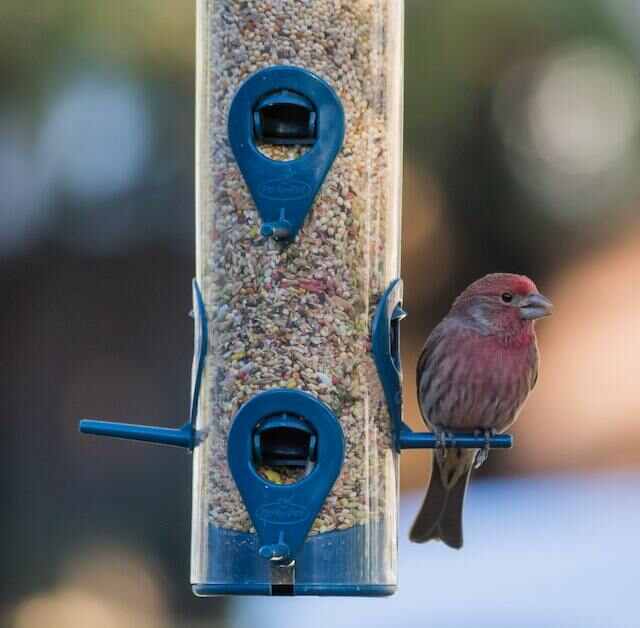
Environmental Factors and Feeder Placement
When it comes to attracting birds to feeders and minimizing seed wastage, considering environmental factors and feeder placement is crucial. Various aspects of the environment can impact bird feeding behavior, such as the presence of predators and the availability of natural food sources. Additionally, the location and orientation of feeders can also affect seed spillage.
One critical factor to consider is predator presence. If birds feel threatened, they may avoid feeding altogether. Placing feeders in an open area with unobstructed views can provide birds with a clear line of sight to potential predators. Additionally, placing feeders at a safe distance from shrubs or trees can also discourage predators from attacking birds at the feeders.
The location of feeders can also impact seed spillage. If feeders are placed too close to each other, birds may knock seeds out of one feeder while feeding from another. Alternatively, if feeders are placed too far apart, birds may drop seeds while flying between feeders. Finding the right balance is crucial to minimizing seed wastage.
The orientation of feeders can also affect seed spillage. Placing feeders on a slant or incline can cause seeds to spill out the sides or front. Ensuring feeders are level and secure can help reduce seed spillage and provide a stable feeding platform for birds.
Overall, considering environmental factors and feeder placement is essential for attracting birds to feeders while minimizing seed wastage. By providing a safe feeding environment and optimizing feeder location, you can enjoy the beauty of birds while promoting responsible bird feeding practices.
Managing Seed Spillage
Seed spillage is a common issue that can result in a waste of resources and a messy feeding area. However, there are effective ways to prevent seed spillage and ensure that your feeders are functioning optimally.
One way to prevent seed spillage is by using feeders with trays or baffles that can catch and redirect the seed back into the feeder. These devices can significantly reduce seed wastage and keep your feeding area tidy.
Another effective strategy is to use smaller feeders that birds can easily empty. By using smaller feeders, you can minimize the amount of seed that sits in the feeder and reduce the likelihood of spillage.
Another way to manage seed spillage is by monitoring the feeders’ seed levels regularly. When the seed levels are low, it can increase the chances of spillage as birds work to access the remaining seed. Keeping the feeders full can reduce the likelihood of seed spillage and ensure that birds have a steady supply of food.
Finally, you can try adjusting the feeder’s placement to minimize the impact of environmental factors that can contribute to seed wastage. For example, placing the feeder in areas with less wind or arranging them in a sheltered area can reduce the chances of spillage.
By implementing these strategies, you can reduce seed wastage and maintain a clean and efficient feeding area. Remember to observe the birds in your feeding area and make adjustments to optimize their feeding habits.
Observing Birds and Adjusting Feeder Setup
Observing birds at your bird feeder pole is an excellent way to understand their feeding behavior. By paying attention to the types of seeds they prefer, the time of day they visit, and how they interact with the feeder, you can make adjustments to optimize their feeding habits.
One important factor to consider is the placement of your feeder on the bird feeder pole. Birds are more likely to frequent feeders that are in a sheltered area, away from predators. If your feeder is placed in an open area, try moving it closer to trees or shrubs on the bird feeder pole. This will provide birds with cover while they feed.
You can also experiment with different types of feeders on the bird feeder pole. Some birds prefer certain feeder styles, such as tube or platform feeders. If you notice that birds are having trouble perching on your current feeder, consider switching to a platform feeder on the bird feeder pole that allows them to stand while they eat.
Another adjustment to consider is the amount of seed you provide on the bird feeder pole. Birds will often throw seed out of feeders if there is too much seed present. Try filling your feeder halfway and refilling it more frequently on the bird feeder pole. This will not only minimize seed wastage but also provide birds with fresh seed.
Finally, it’s essential to keep your feeding area tidy around the bird feeder pole. Seed hulls and debris can accumulate, which can deter birds from visiting. Regular cleaning of your feeder and the surrounding area will ensure a clean and inviting feeding environment on the bird feeder pole.
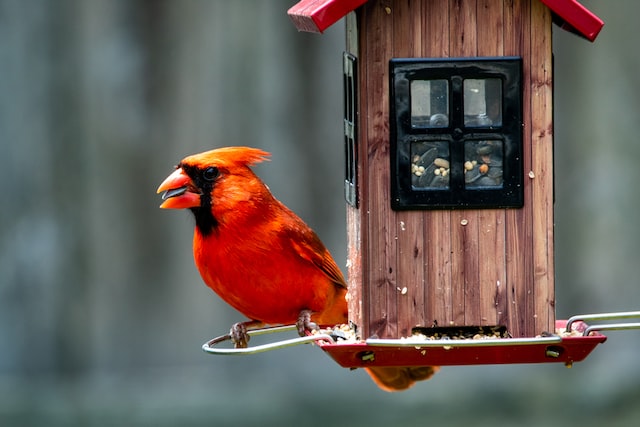
Promoting Responsible Bird Feeding
As bird enthusiasts, it’s our responsibility to feed birds in a way that minimizes harm to both the birds and the environment. This means considering the impact of our actions and making conscious decisions to promote responsible bird feeding.Here are some tips for promoting responsible bird feeding:
- Provide only the amount of food that will be consumed each day to minimize waste and avoid attracting unwanted pests.
- Keep feeding areas clean and tidy to prevent the spread of disease among birds.
- Avoid providing foods that are harmful to birds, such as bread or processed foods.
- Choose a feeder location that is safe from predators and does not pose a risk to the birds.
- Monitor the behavior of birds at your feeders and adjust your setup as needed to encourage responsible feeding habits.
By adopting responsible feeding practices, we can help protect both the birds and the environment they inhabit. Let’s work together to create a safe and sustainable feeding environment for all.
Extra Tips
Birds are great to have around, but they can be a little messy. The seeds that they throw out of the feeder can get on your patio or even in your house if you have one nearby. These tips will help you stop birds from throwing seed out of the feeder so that it doesn’t make such a mess everywhere.
1). Place the bird feeder on top of something like an upside down pot with holes in it, or some old pantyhose stretched over the top.
2). Use a window feeder so that birds can eat, but seed won’t fall out on the ground.
3). Cover an old pie tin with chicken wire to make a smaller area for feeding without food spilling onto the ground or into your lawn furniture.
4). Keep squirrels away from bird feeders by attaching strings of reflective Mylar tape, metallic ribbon, or strands of aluminum foil to them in various lengths and directions-these are all noxious to animals who have a good sense of smell.
5) Place the feeder on a stand or mount it to a post so that birds must step up to reach the seed.
6) Cover the feeder to keep birds from seeing the seed.
7) Purchase a feeder with an adjustable weight system that forces birds to work for their food by “hunting” for it.
8) Purchase a feeder with an adjustable weight system that forces birds to work for their food by “hunting” for it.
Conclusion
In conclusion, understanding why birds throw seed out of feeders requires a comprehensive understanding of bird behavior, feeding habits, and environmental factors. By implementing strategies, such as choosing appropriate feeder placement and seed selection, you can minimize seed wastage and attract more birds to your feeders.
Observing bird behavior and fine-tuning your feeder setup can also help optimize their feeding habits. Promoting responsible bird feeding involves not only providing food but also considering the impact on the birds and the environment.
By taking steps to minimize seed wastage and create an enjoyable and efficient feeding experience, you can help support the thriving bird populations in your area. So, go ahead and explore the fascinating behavior of birds at your bird feeders!
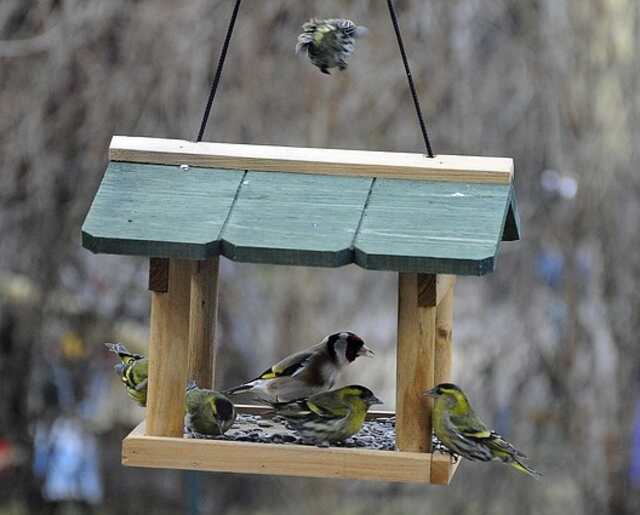
FAQs
How can I prevent seed spillage at bird feeders?
To minimize seed wastage, you can try using feeders with smaller openings or mesh cages that allow for selective feeding. You can also opt for feeders with trays or catchers that collect the fallen seeds. Another strategy is to use seed blends specifically formulated for your target bird species, reducing the chance of unwanted seeds being discarded. Regularly cleaning your feeders and removing spoiled or wet seed can also help prevent spillage.
What are some bird feeding tips to attract birds to my feeders?
To attract birds to your feeders, consider offering a variety of food options, such as different seed types, suet, or nectar. Providing a water source nearby, like a birdbath, can also be appealing to birds. Make sure to place your feeders in a safe and accessible location, away from predators and sheltered from extreme weather conditions. Finally, maintain a consistent feeding routine to establish a reliable food source for the birds.
How does a bird’s beak size and shape influence seed spillage?
The size and shape of a bird’s beak play a role in how they handle and consume seeds. Birds with larger, stronger beaks may be more efficient at cracking and opening seeds, resulting in fewer spillages. On the other hand, birds with smaller or more specialized beaks may struggle with certain seed types, leading to more seed scatter. Understanding the beak characteristics of your target bird species can help you select appropriate feeders and seeds.
Do birds have preferences when selecting seeds?
Yes, birds often have preferences when it comes to selecting seeds. Different bird species have different dietary habits and taste preferences. Some birds may favor sunflower seeds, while others may prefer nyjer seeds or millet. By offering a variety of seeds, you can cater to a broader range of bird species and increase the chances of attracting the birds you desire. Observing the feeding behavior of the birds in your area can provide insights into their seed preferences.
How does the environment and feeder placement affect seed spillage?
The environment and the placement of your bird feeders can impact seed wastage. For example, feeders placed in open areas may be more susceptible to wind, causing seed spillage. Similarly, if your feeders are easily accessible to squirrels or larger birds, they may cause more disruption and seed scatter. Placing feeders near sheltered areas or using baffles and squirrel-proofing measures can help mitigate these issues.
What can I do to manage seed spillage at my feeders?
To manage seed spillage, consider investing in feeders with built-in trays or catchers that can collect the fallen seeds. Regularly cleaning your feeders and removing old or spoiled seed can also minimize wastage. If you notice specific areas where seed spillage is more common, you can place a tray underneath the feeder to catch any scattered seeds. Additionally, using smaller seed blends or feeder designs that promote selective feeding can help reduce overall wastage.
How can I observe birds and adjust my feeder setup?
Observing the behavior of birds at your feeders is key to understanding their preferences and making adjustments to optimize their feeding habits. Spend time watching the birds and taking note of things like which feeders they prefer, which seeds they prefer, and any patterns in their feeding behavior. Based on your observations, you can make changes to the types of feeders, seeds, or feeder placements to better accommodate the birds’ needs and minimize seed spillage.
How can I practice responsible bird feeding?
Responsible bird feeding involves considering the well-being of the birds and the environment. To feed birds responsibly, ensure that you are providing a balanced and varied diet that meets their nutritional needs. Avoid offering spoiled or moldy seeds, as they can be harmful to birds’ health. It’s also important to keep your feeding area clean, regularly removing any accumulated debris or droppings. Additionally, take steps to minimize seed wastage and avoid overfeeding, as excessive food availability can disrupt natural foraging behaviors.
What causes birds to throw seeds out of feeder?
There are many reasons why birds might throw seeds out of a feeder. Some birds might be looking for a specific type of seed, and if they don’t find it in the feeder, they might throw the seed out.
Other birds might not be able to reach the food in the feeder, so they might throw the seed out to get it closer to them. And some birds might just be messy eaters!
How can we stop birds from throwing seeds out of feeder?
There are a few things that can be done in order to help stop birds from throwing seeds out of feeders. One thing is to make sure that the feeder is placed in an area where the birds have plenty of room to perch and eat.
Another thing that can be done is to use a feeder that has a roof or a cover, as this will help to keep the seeds inside. Additionally, it is important to keep the feeder clean and filled with fresh food, as this will also help to keep the birds from throwing the seeds out.
How do I keep seeds from falling off my bird feeder?
To keep the seeds from falling off your bird feeder, you can try a few things. One is to use a wire mesh or metal cage around the feeder. This will help keep the birds from being able to take the seeds off with their beaks.
Another option is to use a baffle. This is a cone or cylinder that is placed above or below the feeder. It will stop the seeds from falling out and help keep them in the feeder.
How to stop bird seed from going everywhere?
There are a few ways to stop bird seed from going everywhere when you are filling up your bird feeders. One way is to put the bird feeder on a platform or tripod so that the seed falls through the openings and not all over the ground.
You can also put a tray or dish under the bird feeder to catch the seed. Another way to stop the seed from spilling is to use a funnel when filling up your bird feeders.
How to stop bird seed from growing under feeder?
One way to stop bird seed from growing under your feeder is to place a large rock or other heavy object on top of the feeder. This will help to keep the seed in place and prevent it from spreading.
Another option is to use a feeder with a built-in tray or skirt, which will help to keep the seed from falling to the ground.
Do birds scatter seeds when feeding?
There is some debate over whether or not birds scatter seeds when feeding. Some people believe that the seeds are simply knocked out of the bird’s beak as it eats, while others think that the bird purposefully spreads the seeds around.
There is evidence of both behaviors, so it is hard to say for sure which is correct. What is known, however, is that birds are an important part of the seed dispersal process. They help to spread seeds to new areas, which helps to create new habitats and ecosystems.
Will birds eat seed off the ground?
Some people believe that birds will not eat seed off the ground, but this is not true. Birds will eat seed off the ground if it is the only food available to them. However, if there is food available in a bird feeder, the birds will likely prefer to eat from the feeder.
Some birds, like sparrows, will eat seed off the ground, while others, like blue jays, will not. It is also important to consider what type of seed it is. Some seeds, like sunflower seeds, are designed to be eaten off the ground, while others, like millet, are not.
Do birds eat the whole seed when feeding?
Birds will usually eat the entire seed when feeding. However, there are a few exceptions. Some birds, such as the black-capped chickadee, will eat only the kernel of the seed and discard the rest. Others, such as the American Goldfinch, will eat mostly the kernel but will also consume some of the shell.

